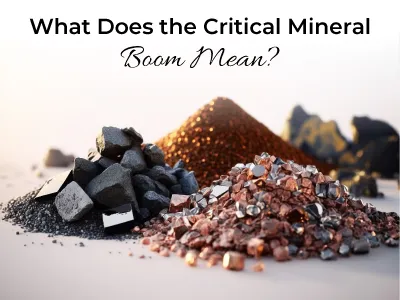
The global energy transition brings opportunities and risks for developing countries.
While the global energy transition offers mineral-rich countries the chance to strengthen their industries and diversify their economies, it also risks deepening their dependence on commodities. In this context,
- Demand for critical energy transition minerals such as lithium, cobalt, and copper could almost quadruple by 2030.
- Many developing countries have these minerals but need more processing capacity to add value.
- Commodity dependency affects 66 percent of small island developing states, 83 percent of least developed countries, and 85 percent of landlocked developing countries.
As the climate emergency escalates, so does the demand for minerals crucial for renewable energy technologies like solar panels, wind turbines, and electric vehicles (EVs). A UNCTAD report, drawing on data from the International Energy Agency, projects that demand for lithium could surge by over 1,500 percent by 2050, with similar spikes expected for nickel, cobalt, and copper. This exponential growth in demand presents significant opportunities and challenges for developing countries endowed with critical energy transition minerals , particularly those grappling with commodity dependence (where 60 percent or more of a country's trade export revenue comes from raw materials).
Such dependency hinders economic development and perpetuates inequalities and vulnerabilities in sub-Saharan Africa, South America, the Pacific, and the Middle East. It currently affects 95 developing countries, almost half of which are UN members. Of the 32 countries classified as having low human development in 2021, 29 were also commodity-dependent.
"Commodities and commodity dependence are issues at the heart of trade and development's past and, in particular, its future," said Rebeca Grynspan, UN Secretary-General for Trade and Development.
$225 billion investment gap in critical mining projects
Global investment in critical energy transition minerals must catch up with growing demand. Moreover, current production levels are insufficient to meet the need to limit global warming to 1,5°C, which is in line with the Paris Agreement.
In this context, the UN Department for Trade and Development has identified 110 new mining projects worth $39 billion worldwide, with $22 billion invested in 60 projects in developing countries. However, the sector may need around 80 new copper mines, 70 new lithium and nickel mines, and 30 new cobalt mines to meet the 2030 net zero emissions targets. The investment needed between 2022 and 2030 ranges from $360 billion to $450 billion, potentially leaving a gap of $180 billion to $270 billion. The most significant shortages are in copper and nickel, accounting for 36 percent and 16 percent of the total shortfall, respectively.
Mineral-rich developing countries need to add value locally
Much-needed new critical mineral mining projects offer opportunities for many developing countries, especially in Africa. The continent has over a fifth of the world's reserves of a dozen metals essential for energy transformation, including 19 percent of those needed for electric vehicles.
However, to truly harness their mineral wealth, developing countries must strive for more than just raw mineral extraction. The key lies in ascending the value chains. A comprehensive analysis of electric vehicle supply chains by the UN Department for Trade and Development underscores the fact that no country from Africa or Latin America currently holds a significant role in the production or trade of cathode or battery materials.
Global support is critical to avoiding the past pitfalls of commodity dependency
To strengthen their industrial sectors, diversify their economies, and redefine their role in the global economy, developing countries rich in critical energy transition minerals must avoid the past pitfalls of commodity dependence.
Otherwise, increasing demand for these minerals could further strengthen their commodity dependence, exacerbating economic vulnerabilities while the benefits for local communities and businesses remain out of reach.
Global support is critical to avoiding the past pitfalls of commodity dependency
To strengthen their industrial sectors, diversify their economies, and redefine their role in the global economy, developing countries rich in critical energy transition minerals must avoid the past pitfalls of commodity dependence.
Failure to act could lead to a dangerous increase in commodity dependence, heightening economic vulnerabilities and keeping the benefits for local communities and businesses out of reach.
The UN Trade and Development Organization, a key advocate, is pushing for more sustainable and transparent mining contracts and exploration licenses. This support is crucial in enabling local firms in developing countries to participate in the value chain of renewable energy components.
In this context, UN Trade and Development and UN Secretary-General António Guterres are providing analysis of this sector's trade and development aspects to the Panel on Critical Energy Transition Minerals, established at the COP28 climate summit and launched on April 26.
“There is an opportunity to take advantage of this new commodity to update our trade regime, promote structural diversification, and fully reverse the trajectory of commodity dependency,” said UN Secretary-General for Trade and Development Rebeca Grynspan.
 Back
Back







